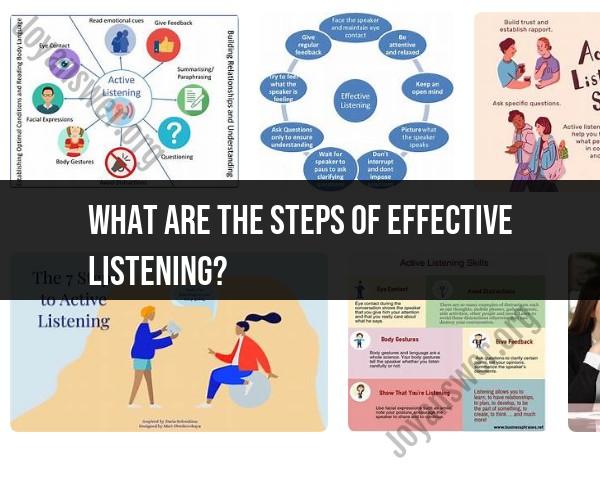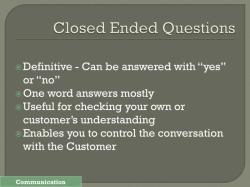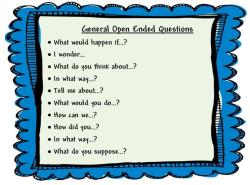What are the steps of effective listening?
Effective listening involves a series of steps that help in comprehending, interpreting, and responding to the speaker's message. Here are the steps to enhance your listening process:
1. Prepare Yourself Mentally:
- Clear Your Mind: Focus on the speaker and the message they're conveying. Put aside distractions and be mentally present.
- Open Attitude: Approach the conversation with an open mind, ready to understand the speaker's perspective without preconceptions or judgments.
2. Receive the Message:
- Pay Attention: Actively focus on the speaker's words and nonverbal cues to receive the complete message.
- Nonverbal Cues: Observe the speaker's body language, tone, and facial expressions for additional context.
3. Understand and Interpret:
- Comprehend the Message: Seek to understand the speaker's main points, underlying emotions, and intentions.
- Clarify Ambiguities: If unsure about any part of the message, ask clarifying questions to ensure accurate comprehension.
4. Evaluate and Analyze:
- Reflect on the Message: Analyze the information provided and think critically about its implications or significance.
- Consider Perspectives: Acknowledge different viewpoints and consider how the message aligns with various perspectives.
5. Respond Appropriately:
- Provide Feedback: Respond to the speaker to indicate your understanding and interest. Use verbal and nonverbal cues to show engagement.
- Ask Questions: Ask relevant questions to seek further information or clarification, showing interest in the speaker's thoughts.
6. Remember and Retain:
- Remember Key Points: Make an effort to remember essential details and key points from the conversation.
- Take Notes if Necessary: Note-taking can aid in retaining important information, especially in situations with complex or detailed discussions.
7. Confirm Understanding:
- Summarize or Paraphrase: Summarize the speaker's message or paraphrase it to confirm your understanding. This demonstrates active listening and ensures accuracy in comprehension.
- Seek Confirmation: Ask the speaker if your understanding aligns with their intended message.
8. Respond Appropriately:
- Provide Constructive Responses: Respond with empathy, understanding, and relevance, ensuring your response aligns with the speaker's message.
9. Follow-Up and Action:
- Follow-Up Actions: If required, clarify any action items or commitments resulting from the conversation to ensure mutual understanding.
Practicing these steps consistently can significantly improve your listening skills, enhance communication, and strengthen relationships by demonstrating genuine interest and understanding of others' perspectives.
Active listening is a skill that can be cultivated and honed, allowing us to engage more effectively in conversations and build meaningful connections. By following these five steps, we can set ourselves up for listening success and maximize our understanding of others.
1. Preparing for Listening Success
Before engaging in a conversation, it's crucial to set the stage for optimal engagement. Find a quiet and distraction-free environment where you can give the speaker your undivided attention. Adopt a relaxed and open posture, and make eye contact with the speaker to signal your attentiveness.
2. Giving the Speaker Your Undivided Attention
Effective listening requires putting aside your own thoughts and distractions to fully focus on the speaker's message. Silence your inner monologue, resist the urge to interrupt, and avoid multitasking. Dedicate your full attention to the speaker's words, both verbal and nonverbal.
3. Listening with Intent to Understand
Shift your mindset from simply hearing the speaker's words to actively seeking to understand their underlying meaning. Listen not just with your ears but also with your mind and heart. Try to grasp their perspective, their emotions, and the context of their message.
4. Seeking Clarification When Needed
Don't hesitate to ask clarifying questions if something is unclear or ambiguous. Asking questions demonstrates engagement and a desire for deeper understanding. It's better to ask for clarification than to assume something incorrectly and potentially misinterpret the speaker's message.
5. Demonstrating Understanding through Paraphrasing and Summarizing
Paraphrasing and summarizing are powerful tools for reinforcing understanding and confirming that you've grasped the speaker's message. Briefly rephrase what the speaker has said in your own words, ensuring that you've captured the essence of their thoughts and feelings. Summarizing at intervals helps consolidate the key points of the conversation.
By following these steps, we can become more active and effective listeners, fostering meaningful connections, enriching conversations, and building stronger relationships with others.












